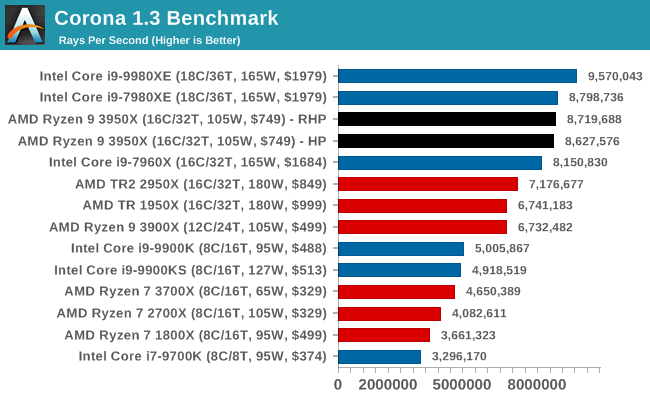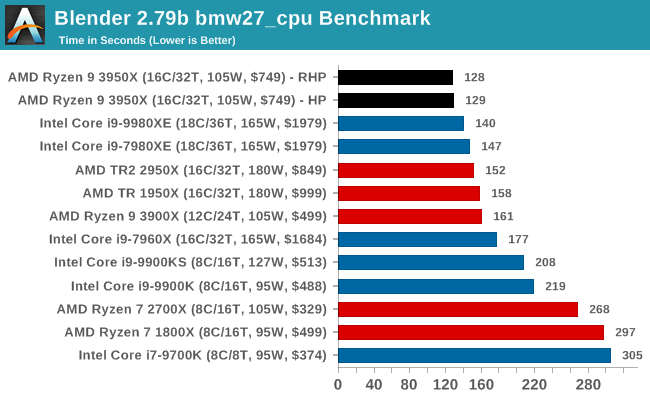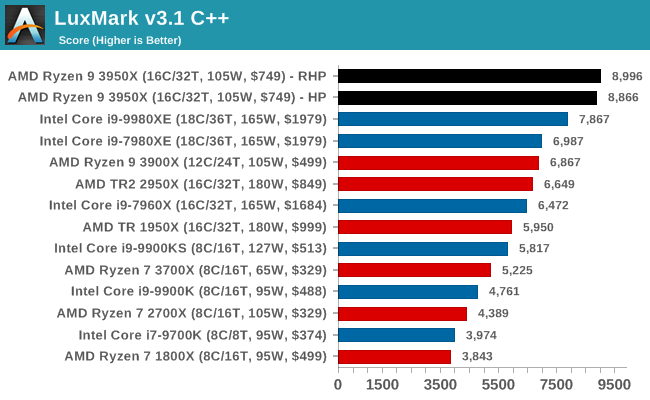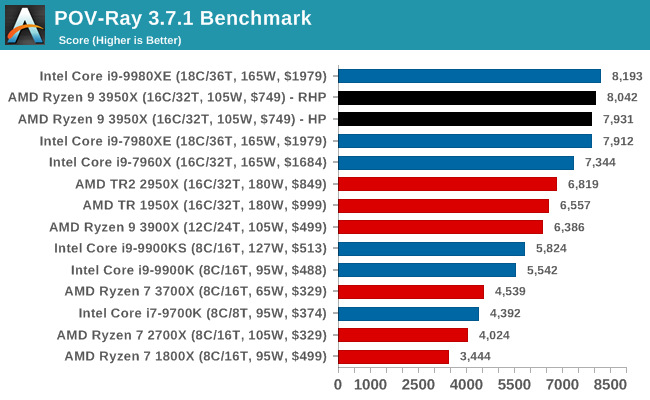The AMD Ryzen 9 3950X Review: 16 Cores on 7nm with PCIe 4.0
by Dr. Ian Cutress on November 14, 2019 9:00 AM ESTCPU Performance: Rendering Tests
Rendering is often a key target for processor workloads, lending itself to a professional environment. It comes in different formats as well, from 3D rendering through rasterization, such as games, or by ray tracing, and invokes the ability of the software to manage meshes, textures, collisions, aliasing, physics (in animations), and discarding unnecessary work. Most renderers offer CPU code paths, while a few use GPUs and select environments use FPGAs or dedicated ASICs. For big studios however, CPUs are still the hardware of choice.
All of our benchmark results can also be found in our benchmark engine, Bench.
Corona 1.3: Performance Render
An advanced performance based renderer for software such as 3ds Max and Cinema 4D, the Corona benchmark renders a generated scene as a standard under its 1.3 software version. Normally the GUI implementation of the benchmark shows the scene being built, and allows the user to upload the result as a ‘time to complete’.
We got in contact with the developer who gave us a command line version of the benchmark that does a direct output of results. Rather than reporting time, we report the average number of rays per second across six runs, as the performance scaling of a result per unit time is typically visually easier to understand.
The Corona benchmark website can be found at https://corona-renderer.com/benchmark

Intel's HEDT chips are quite good at Corona, but if we compare the 3900X to the 3950X, we still see some good scaling.
Blender 2.79b: 3D Creation Suite
A high profile rendering tool, Blender is open-source allowing for massive amounts of configurability, and is used by a number of high-profile animation studios worldwide. The organization recently released a Blender benchmark package, a couple of weeks after we had narrowed our Blender test for our new suite, however their test can take over an hour. For our results, we run one of the sub-tests in that suite through the command line - a standard ‘bmw27’ scene in CPU only mode, and measure the time to complete the render.
Blender can be downloaded at https://www.blender.org/download/

AMD is taking the lead in our blender test, with the 16-core chips easily going through Intel's latest 18-core hardware.
LuxMark v3.1: LuxRender via Different Code Paths
As stated at the top, there are many different ways to process rendering data: CPU, GPU, Accelerator, and others. On top of that, there are many frameworks and APIs in which to program, depending on how the software will be used. LuxMark, a benchmark developed using the LuxRender engine, offers several different scenes and APIs.
In our test, we run the simple ‘Ball’ scene on both the C++ code path, in CPU mode. This scene starts with a rough render and slowly improves the quality over two minutes, giving a final result in what is essentially an average ‘kilorays per second’.

Despite using Intel's Embree engine, again AMD's 16-cores easily win out against Intel's 18-core chips, at under half the cost.
POV-Ray 3.7.1: Ray Tracing
The Persistence of Vision ray tracing engine is another well-known benchmarking tool, which was in a state of relative hibernation until AMD released its Zen processors, to which suddenly both Intel and AMD were submitting code to the main branch of the open source project. For our test, we use the built-in benchmark for all-cores, called from the command line.
POV-Ray can be downloaded from http://www.povray.org/

POV-Ray ends up with AMD 16-core splitting the two Intel 18-core parts, which means we're likely to see the Intel Core i9-10980XE at the top here. It would have been interesting to see where an Intel 16-core Core-X on Cascade would end up for a direct comparison, but Intel has no new 16-core chip planned.











206 Comments
View All Comments
Slash3 - Thursday, November 14, 2019 - link
Intel is subsidizing retailer discounts in an effort to smooth over the transition to the newer Cascade Lake-X chips. It's part of their $3B marketing and incentive campaign. Subsequent fulfillment from Intel is at the reduced (but unofficial) lower pricing.https://www.computerbase.de/2019-10/high-end-cpu-i...
Intel gets to clear remaining stock and retailers avoid taking a bath on previously purchased CPUs. Makes sense.
Spunjji - Thursday, November 14, 2019 - link
If retailers had to drop prices that much to clear stock and Intel weren't chipping in to compensate, we'd definitely be hearing about it.Phynaz - Thursday, November 14, 2019 - link
Intel will be price protecting them.Ratman6161 - Thursday, November 14, 2019 - link
Personal opinion from someone who is NOT in the HEDT market: People whose work/Livelihood comes from tasks that are noticeably better on an HEDT platform, probably don't care about the price or at least don't care as much as the rest of us do. All the math works out differently if you can actually take advantage of the things other than the CPU that HEDT offers. So I think there is still a pretty firm dividing line between x299 and thread ripper on one side and everything else in this test on the other.Just saying that price only becomes a deciding factor AFTER you decide which side of that line you are on.
AIV - Thursday, November 14, 2019 - link
3950X blurs the line between HEDT and Desktop market. New 16 core EPYC rome (e.g 7302P is less than 1000EUR) along threadripper makes the market segmentation even more blurry. Especially at ~16 cores there are many alternatives in multiple product families.phoenix_rizzen - Thursday, November 14, 2019 - link
Yeah, you can now start mixing and matching CPUs based on your other needs (PCIe lanes, I/O support, memory channels, memory speeds, graphics, etc).Ryzen CPUs give you dual-channel memory and 24 (16+4+4) PCIe lanes.
Threadripper CPUs give you quad-channel memory and 88 (64+16+8) PCIe lanes.
EPYC CPUs give you octo-channel memory and 128 PCIe lanes.
Figure out how much memory and I/O you need, then choose the CPU with the number of cores you want.
From 2-core Athlons with integrated graphics to 64-core monsters, there's plenty of choices along the way. :)
8-core Ryzen 7
8-core EPYC
12-core Ryzen 9
12-core EPYC
16-core Ryzen 9
16-core Threadripper
16-core EPYC
24-core Threadripper
24-core EPYC
32-core Threadripper
32-core EPYC
lobz - Thursday, November 14, 2019 - link
It's still a bad deal for that price. That CPU is on a dead platform.Phynaz - Thursday, November 14, 2019 - link
Kinda like Threadripper, eh?yeeeeman - Thursday, November 14, 2019 - link
This CPU basically renders Intel CPU until 1000$ useless. Only 9900KS brings something extra in gaming and general app usage. Threadripper will do the same for higher end 1000$+ market. This is the first time in many many years when AMD is better in pretty much all price categories, period.Total Meltdowner - Thursday, November 14, 2019 - link
Glad I bought AMD Stock 3 years ago. Wish I had invested more... sigh.